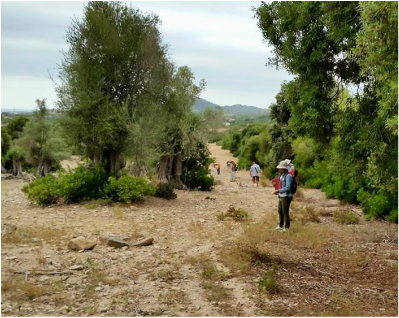2015 Campaign

In 2015, the LEIA Project continued the twin strategies of excavation and survey in the Son Servera municipality. Along with these more traditional field methods, the team experimented with 3D mapping techniques. As a result, we were able to create 3D representations of both the Mestre Ramon site as well as a nearby talaiot site.
Another change in 2015 was an intensification of the laboratory efforts. The team completed a more detailed analysis of the survey ceramics from 2014 while at the same time processing all of the 2015 finds.
The summer of 2015 also saw a major expansion of the field team. A group of graduate and undergraduate archaeology students from various Spanish universities joined the University of Washington field school crew, doubling the size of the team.
Another change in 2015 was an intensification of the laboratory efforts. The team completed a more detailed analysis of the survey ceramics from 2014 while at the same time processing all of the 2015 finds.
The summer of 2015 also saw a major expansion of the field team. A group of graduate and undergraduate archaeology students from various Spanish universities joined the University of Washington field school crew, doubling the size of the team.
Excavation

Excavations at the site of Mestre Ramon focused on better understanding the earliest uses of the site on and around the top of the stepped tumulus. In particular, the team worked to uncover and describe an apparent corridor leading towards the peak of the tumulus. Corridors have been identified at other similar "stepped tumuli", so excavating the corridor at Mestre Ramon allows for interesting comparisons to be made.
The most comparable site is the site of Son Oms, located near the Palma de Mallorca Airport. At Son Oms, archaeologists were able to identify a corridor that led from a lower step of the tumulus to the top with two turns, possibly suggesting it was used for processions. This evidence has been used to support the interpretation that the stepped tumulus structures were used primarily for rituals or other symbolic activities.
The 2015 excavations at Mestre Ramon revealed a surprisingly similar layout. The corridor proceeds from a lower step before taking an abrupt right turn. This can be seen rather clearly at the center of the overhead photo on the left.
The most comparable site is the site of Son Oms, located near the Palma de Mallorca Airport. At Son Oms, archaeologists were able to identify a corridor that led from a lower step of the tumulus to the top with two turns, possibly suggesting it was used for processions. This evidence has been used to support the interpretation that the stepped tumulus structures were used primarily for rituals or other symbolic activities.
The 2015 excavations at Mestre Ramon revealed a surprisingly similar layout. The corridor proceeds from a lower step before taking an abrupt right turn. This can be seen rather clearly at the center of the overhead photo on the left.
Survey

The survey team focused their efforts on covering large territories in the northwestern part of Son Servera. No archaeological sites had been previously recorded in these areas, so it was a good chance for the team to document areas that are often described as "off-site".
In just about 12 days of surveying, the team was able to survey 6,084 points* on the landscape, a major increase on the ~2,600 points surveyed in 2014. In the end, 4,622 artifacts were found in the 2015 survey.
* A "point" in our methodology is a circular collection area of 5 sq. meters around a central point where the GPS reading is taken.
In just about 12 days of surveying, the team was able to survey 6,084 points* on the landscape, a major increase on the ~2,600 points surveyed in 2014. In the end, 4,622 artifacts were found in the 2015 survey.
* A "point" in our methodology is a circular collection area of 5 sq. meters around a central point where the GPS reading is taken.
Laboratory Analysis

In the lab, the team focused their efforts on processing pottery from the survey. This analysis was greatly aided by a new online database entry system created by Dave Hunt. First, all of the 2014 survey materials were re-analyzed and entered into the new database system. Next, all of the 2015 materials were analyzed.
The analysis of ceramics consisted of two stages:
In total, the team was able to process over 9,600 artifacts in just a few short weeks.
The analysis of ceramics consisted of two stages:
- characterization of the ceramic piece to see if it fit a known type
- basic metric measurements of the piece
In total, the team was able to process over 9,600 artifacts in just a few short weeks.

